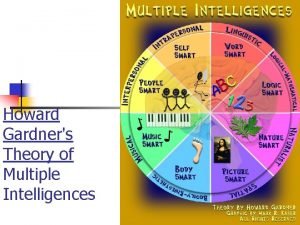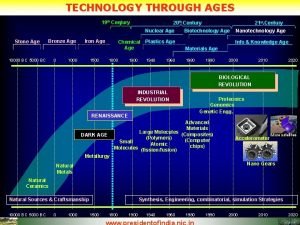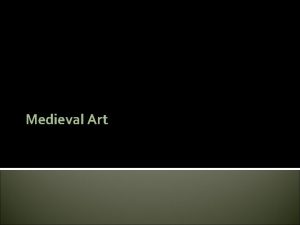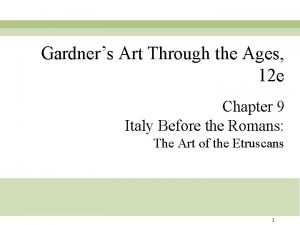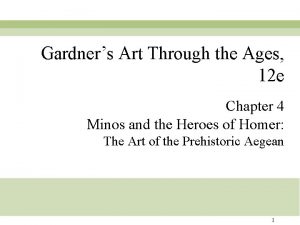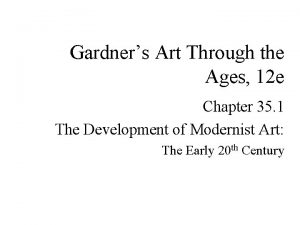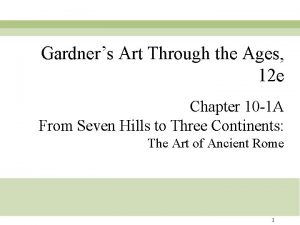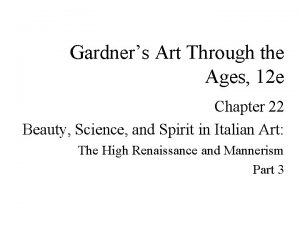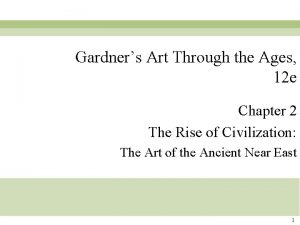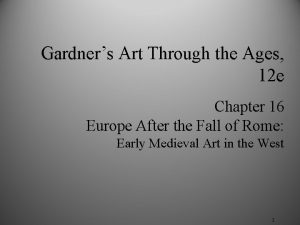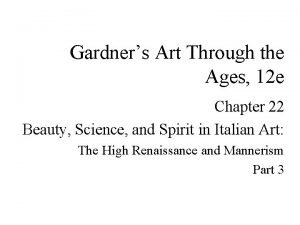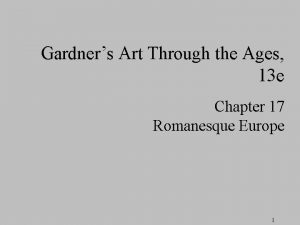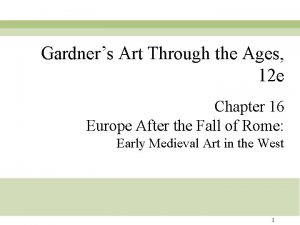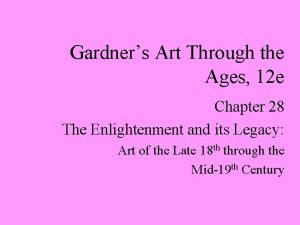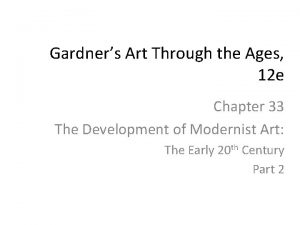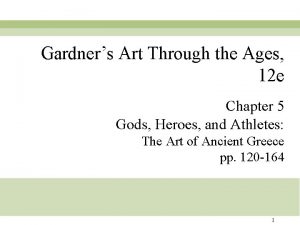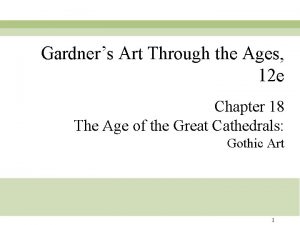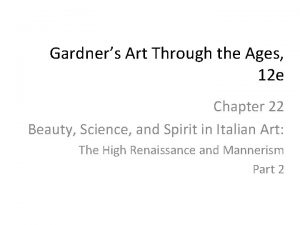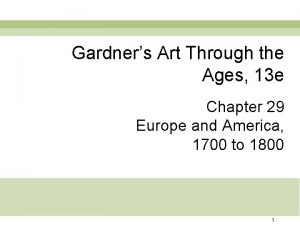Gardners Art Through the Ages 12 e Chapter


















- Slides: 18

Gardner’s Art Through the Ages, 12 e Chapter 29 The Rise of Modernism: Art of the Later 19 th Century Part 2

Industrialization of Europe and U. S. about 1850

Art Nouveau • Art Nouveau was an architectural and design movement that developed out of the ideas of the Arts and Crafts movement. • It was known as Jugenstil in Austria and Germany & Austria, Modernismo in Spain, and Floreale or Liberty in Italy. • Proponents tried to synthesize all the arts in an attempt to create art based on natural forms that could be mass-produced for a large audience. • Stylistically it adapted the twining plant form to the needs of architecture, painting, sculpture and all of the decorative arts. • In design Art Nouveau was characterized by writhing plant forms and an opposition to the historicism which had plagued the 19 th century. • There was a tension implicit throughout the movement between the decorative and the modern • It has a strong emphasis on decoration and artistic unity.

Mila House, looks like a mass of undulating stone where architecture turns into sculpture and where the original roof and chimneys, abstract and anachronistic, are especially eye-catching. ANTONIO GAUDI, Casa Milá, Barcelona, 1907.

Spanish architect Antonio Gaudi created a style that was both modern and appropriate to his country. He conceived of a building as a wholeand molded it almost as a sculptormight shape a figure in clay. Left unfinished at his death in 1926, his La Sagrada Família (The Holy Family) is a large Roman Catholic basilica under construction in Barcelona.

Guell Park in Barcelona (1900 -14), which was planned as an ideal community by Gaudi, in the Arts and Crafts manner, with houses, gardens and a market. Mosaics made from ceramics, broken plates and glass decorate the park walls and bizarre, brightly colored beasts inhabit fountains. The covered market has many complex shapes and structures in its pillars, and its roof is a terrace from which there is a spectacular view of the whole city. Guell Park was never finished, but it is now a popular park.

Fin-de-siecle means “end” of the century, ” but also refers to a certain sensibility. At the end of the 19 th century people were determined to live “the good life” which evolved into a culture of decadence & indulgence, but beneath this there was also anxiety over the political situation & an uncertain future. GUSTAV KLIMT, The Kiss, 1907– 1908. Oil on canvas, 5’ 10 3/4” x 5’ 10 3/4”. Austrian Gallery, Vienna.

In 1897 Klimt, along with 18 other artists formed the Vienna Secession in opposition to the established conservative artists in Vienna. They were Younger & wanted a more open & experimental approach to art. In addition, like the Arts & Crafts movement they called for greater integration between art objects & the

Vienna Secession Building, 1897 - 1898 Joseph Maria Olbrich, Austria

Portrait of Adele Bloch-Bauer I is a painting by Gustav Klimt completed in 1907. According to press reports it was sold for $135 million to Ronald Lauder for his Neue Gallery in New in June 2006, making it at that time the most expensive painting ever sold. It has been on display at the gallery since July 2006.

Architecture in the Later 19 th Century • In the later 19 th century, new technology and the changing needs of urbanized, industrialized society affected architecture throughout the western world. • The tensile strength of iron (esp. steel after 1860) permitted architects to create new designs involving vast enclosed spaces. • The Realist impulse encouraged an architecture that honestly expressed a building’s purpose, rather than disguising a building’s function. . • Designers developed cast iron architecture combined with masonry to create strong, somewhat fire resistant buildings -the skyscraper was born.

ALEXANDREGUSTAVE EIFFEL, Eiffel Tower, Paris, 1889 (photo: 1889– 1890). Wrought iron, 984’ high. Built in 1889 for the World’s Fair, it has become both a global icon of France and one of the most recognizable structures in the world.

The Chicago School of Architecture • In the history of architecture, the Chicago School was a school of architects active in Chicago at the turn of the 20 th century. • Led by Richard Henry Hobson and his foremost student Louis Sullivan, they were among the first to promote the new technologies of steel-frame construction in commercial buildings, and developed a spatial aesthetic which co-evolved with, and then came to influence, parallel developments in European Modernism. • Louis Sullivan is seen as the first truly modern architect. In buildings like the Guaranty (Prudential) Building he expressed the interior’s subdivision on the exterior, as well as the skeletal nature of the supporting structure -- “form follows function. ”

HENRY HOBSON RICHARDSON, Marshall Field wholesale store (demolished), Chicago, 1885– 1887.

LOUIS SULLIVAN, Guaranty (Prudential) Building, Buffalo, 1894– 1896.

Sullivan gave over the lowest two levels of this building to an ornament in cast iron made of wildly fantastic motifs. He gave as much attention to finding new directions in architectural ornament as in the architecture itself -thus he was an important figure in the Art Nouveau movement. LOUIS SULLIVAN, Carson, Pirie, Scott Building, Chicago, 1899–

RICHARD MORRIS HUNT, The Breakers, Newport, Rhode Island, 1892 Morris brought Renaissance and Baroque form to the mansions of America’s new industrial aristocracy in the latter half of the 19 th century.

LOUIS COMFORT TIFFANY, Lotus table lamp, ca. 1905. Leaded Favrile glass, mosaic, and bronze, 2’ 10 1/2” high. Private collection. Objects such as furniture, lights, rugs, and wallpaper with designs inspired by the sensuous opulence of Art Nouveau or fin-de-siecle were popular in the years leading up to World War I.
 Howard gardners theory of multiple intelligences
Howard gardners theory of multiple intelligences Multiple intelligences test
Multiple intelligences test Dark ages vs middle ages
Dark ages vs middle ages Renaissance art vs medieval art
Renaissance art vs medieval art Chapter 7 early childhood ages 3 through 5
Chapter 7 early childhood ages 3 through 5 A pattern repeated through the ages in literature
A pattern repeated through the ages in literature Technology through the ages
Technology through the ages Art of emerging europe middle ages
Art of emerging europe middle ages Characteristic of medieval art
Characteristic of medieval art Lesson 2 the crusades
Lesson 2 the crusades Eleanor of aquitine
Eleanor of aquitine Through one man sin entered the world, and through one man
Through one man sin entered the world, and through one man Class 2 furcation
Class 2 furcation Tangential sawing advantages
Tangential sawing advantages Night of the scorpion theme
Night of the scorpion theme Hình ảnh bộ gõ cơ thể búng tay
Hình ảnh bộ gõ cơ thể búng tay Slidetodoc
Slidetodoc Bổ thể
Bổ thể Tỉ lệ cơ thể trẻ em
Tỉ lệ cơ thể trẻ em

